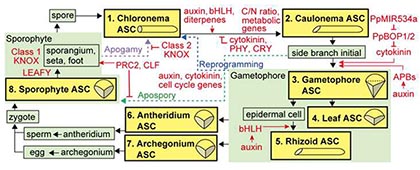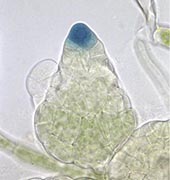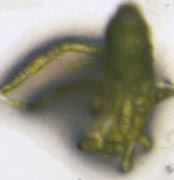RESEARCH: Evolution of life cycle
Mr. Liechi Zhang and Mr. Ruan de Villiers (graduate student in SOKENDAI [The Graduate University for Advanced Studies]) with advices of Assist. Profs. Yosuke Tamada and Masaki Ishikawa.
Land plants have several body plans in their life cycle. For example, the moss Physcomitrella patens changes from hypha-like protonemata to shoot-like gametophores in the haploid generation and sporophytes are formed in the diploid generation. We are interested in the molecular mechanisms how body plants are changed during the life cycle. In non-flowering plants, whole body is originated from a single apical stem cell and the changes of body plans are traced to changes of stem cell characters. Physcomitrella form seven types and one type of stem cells in its haploid and diploid generations, respectively (Kofuji and Hasebe 2014), which carrys the body plan and morphological diversity.
Kofuji, R., and Hasebe, M. (2014). Eight types of stem cells in the life cycle of the moss Physcomitrella patens. Curr. Opin. Plant Biol. 17: 13-21.

Life cycle of Physcomitrella. Different types of stem cells are formed in different timing during the life cycle.
We previously identified molecular switches (1) to produce sporophyte stem cells as polycomb repressive complex 2 gene (Okano et al. 2009), (2) to produce chloronema apical stem cells as class 2 KNOX gene (Sakakibara et al. 2013), and (3) to produce gametophore apical stem cells from protonemata (Aoyama et al. 2012).

A sporophyte formed in the haploid generation of the polycomb repressive complex 2 gene deletion mutant. Class 1 KNOX gene expression is shown as a marker for the sporophyte apical stem cell in blue color.

Protonemata is originated from a sporophyte body without meiosis in the class 2 KNOX deletion mutant.
Okano, Y., Aono, N., Hiwatashi, Y., Murata, T., Nishiyama, T., Ishikawa, T., Kubo, M., and Hasebe, M. (2009). A polycomb repressive complex 2 gene regulates apogamy and gives evolutionary insights into early land plant evolution. Proc. Natl. Acad. Sci. USA 106: 16321-16326.
Sakakibara, K., Ando, S., Yip, H.K., Tamada, Y., Hiwatashi, Y., Murata, T., Deguchi, H., Hasebe, M., and Bowman, J.L. (2013). KNOX2 genes regulate the haploid-to-diploid morphological transition in land plants. Science 339: 1067-1070.
Aoyama, T., Hiwatashi, Y., Shigyo, M., Kofuji, R., Kubo, M., Ito, M., and Hasebe, M. (2012). AP2-type transcription factors determine stem cell identity in the moss Physcomitrella patens. Development 139: 3120-3129.
We found that regulation of auxin level in protonemata is a key for switching protonema apical stem cells or gametophore stem cells. Ruan de Villiers, a graduate student from South Africa found that another phytohormone strigolactore appears to be involved in regulating this process and is working to investigate the strigolactone functions with incorporating auxin cross talks at the cellular level.

